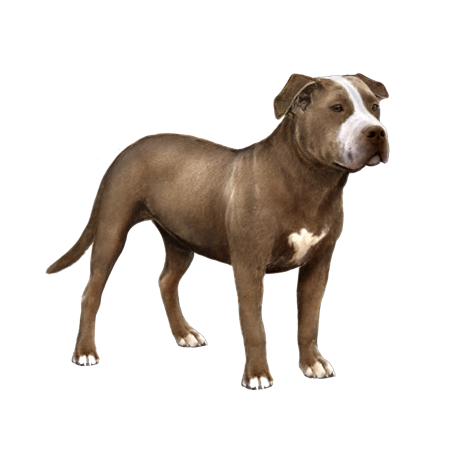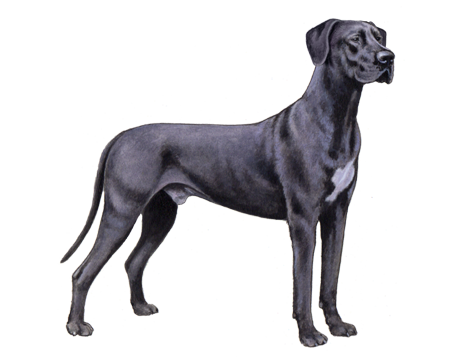
Bulldog
Bulldogs are gentle, loving, and affectionate with their family. This docile, dignified, loyal breed adapts well, whether they live in an urban or rural setting.
Interested in discovering if your dog is a Bulldog?
Check out Wisdom Panel's DNA tests.

Bulldog Traits
General Appearance
Bulldogs have characteristically wide heads and shoulders, black, wide-set eyes, and a short muzzle.
Coat and Coloring
The Bulldog's short, smooth, and glossy coat comes in a variety of colors, including fallow, fawn, brindle, white, and red.
Distinctive Physical Traits
The Bulldog has a recognizable look: loose skin on the head, a wrinkled brow, pushed-in nose, little ears, an underbite with an upturned lower jaw, and droopy skin flanking each side. They also have a unique rolling gait.
Bulldog Temperament
Breeders have worked to reduce aggression in Bulldogs. Now, most dogs of this breed have an easygoing, patient disposition.
They're generally docile, sweet, and friendly. As such, Bulldogs make great family pets. They enjoy lots of attention, and they're eager to please (and curl up in a lap). Bulldogs typically befriend other pets but may be suspicious of unfamiliar dogs.


Bulldog History
The Bulldog of today may look a bit like that of days gone by. But their personalities are nothing alike. Bulldogs were originally developed to be fierce bullfighters, with high pain tolerance and unparalleled aggression. But modern Bulldogs make for much friendlier pups.
The ancestors of Bulldogs—Bullenbeissers, Asian dogs resembling Mastiffs—served as military dogs for the Romans, Teutons, and Celts. And when the Bullenbeissers came to England, breeders worked to reduce the dog's overall size while increasing its head size. The resulting dog was very effective at bull baiting (i.e., pitting a bull against another animal), earning the name "English Bulldog."
Experts believe Bulldogs were first brought to the United States in 1735. Just 100 years later, bull-baiting was outlawed, and breeders started to eliminate the dog's aggressive tendencies. As a result, today's Bulldogs are much calmer and better suited to family life than the Bulldogs of the past.
Bulldog Care
Nutrition
For healthy development, Bulldogs should be fed a high-quality pet food that is age-appropriate.
Bulldogs tend to stay at a good weight. But it's still wise to monitor food intake. Reduce portions or restrict calories if your pup gains weight. Also, remember that giving too many treats can contribute to obesity.
Grooming
Brushing your Bulldog from nose to tail with a soft brush for 10 minutes twice weekly will keep their coat looking good. During heavier shedding, you may want to use a rubber curry brush before the soft brush.
Because Bulldogs have heavily wrinkled faces, they need to be routinely checked to ensure their skin is clean and dry. Food or moisture can get caught in the wrinkles and cause irritation or infection. The ears and the area under the tail should be kept clean as well, and you should trim your Bulldog's nails every two weeks or so.
Exercise
Bulldogs need regular, moderate exercise. (A walk should do.) But you should limit strenuous exercise in the summer months. The Bulldog's short-nosed (a.k.a., brachycephalic) face can make breathing difficult if it's too hot and humid.
Bulldogs like to wade in shallow water. But they should never be allowed in water that's more than elbow deep unless carefully monitored.
Training
To help get your Bulldog off to a good start and curb unwelcome behaviors—such as chewing—begin socialization and training classes early. As your pup grows, firm but gentle training will help you overcome the breed's stubborn tendencies. Reward-based training with small treats is also key.
Bulldogs are less energetic than other breeds, but they still need exercise to avoid becoming obese. Once engaged in an activity, a Bulldog can be rather tenacious and eager to continue playing.
Tug-o-war is a game that Bulldogs love. But remember that puppy training should include teaching your dog to release what's in their mouth on command. Relatedly, Bulldogs can be protective of their food. Nip this tendency in the bud by teaching your pup to be comfortable with people taking food from their bowl while they are eating.

Bulldog Genetic Health Conditions
-
Canine Multifocal Retinopathy 1
Canine Multifocal Retinopathy 1 (CMR1) is an eye disorder that can cause retinal decay which may impact vision, but very rarely results in blindness.
-
Hereditary Calcium Oxalate Urolithiasis, Type 1
Hereditary Calcium Oxalate Urolithiasis, Type 1 (CaOx1) is a genetic disorder that greatly increases the risk for urinary stones composed of calcium oxalate to form within the kidneys or bladder.
-
Hyperuricosuria
Hyperuricosuria (HUU) is a condition that predisposes affected dogs to the formation of urinary stones, such as kidney or bladder stones.
Knowing if your Bulldog is a carrier or at-risk for these conditions can help you and your veterinarian plan for your pup’s lifelong care. With Wisdom Panel™ Premium, you can get results for over 200 genetic health tests.
Breed Group
Guard
Dogs of the Guard Group were bred to guard people and property. They are often quick to learn and these intelligent, capable animals make solid companions.





































